There are no open positions at the moment. Please check back another time for career opportunities!
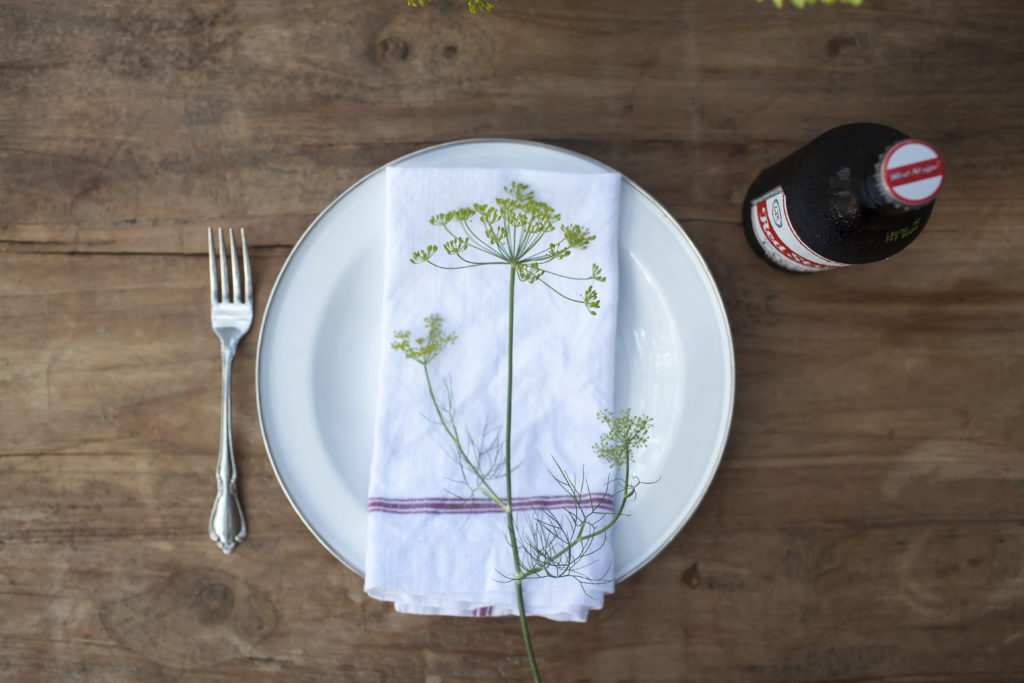

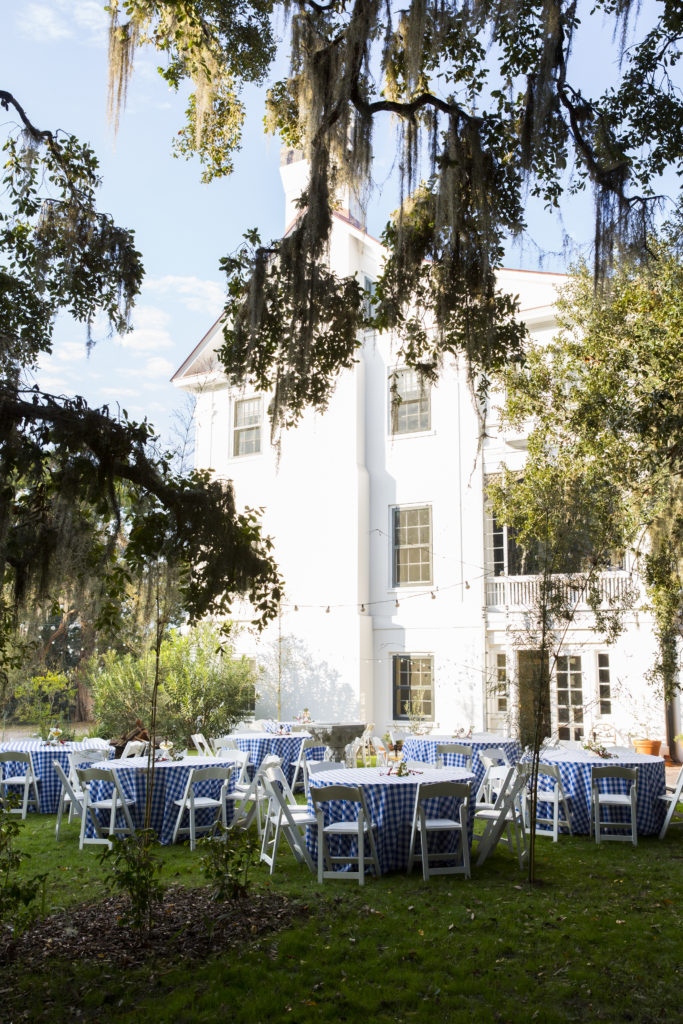
There are no open positions at the moment. Please check back another time for career opportunities!



To Our Guests & Friends,
Over the past decade, it has been our true pleasure to work with Chefs Whitney Otawka and Ben Wheatley — and not only to work alongside them, but to embrace them as part of our Greyfield family.
We’ve seen Whitney and Ben dedicate themselves to the Greyfield culinary program, enriching the experience for each and every guest who has dined at our table and for those of us who have been fortunate enough to enjoy their creations each day.
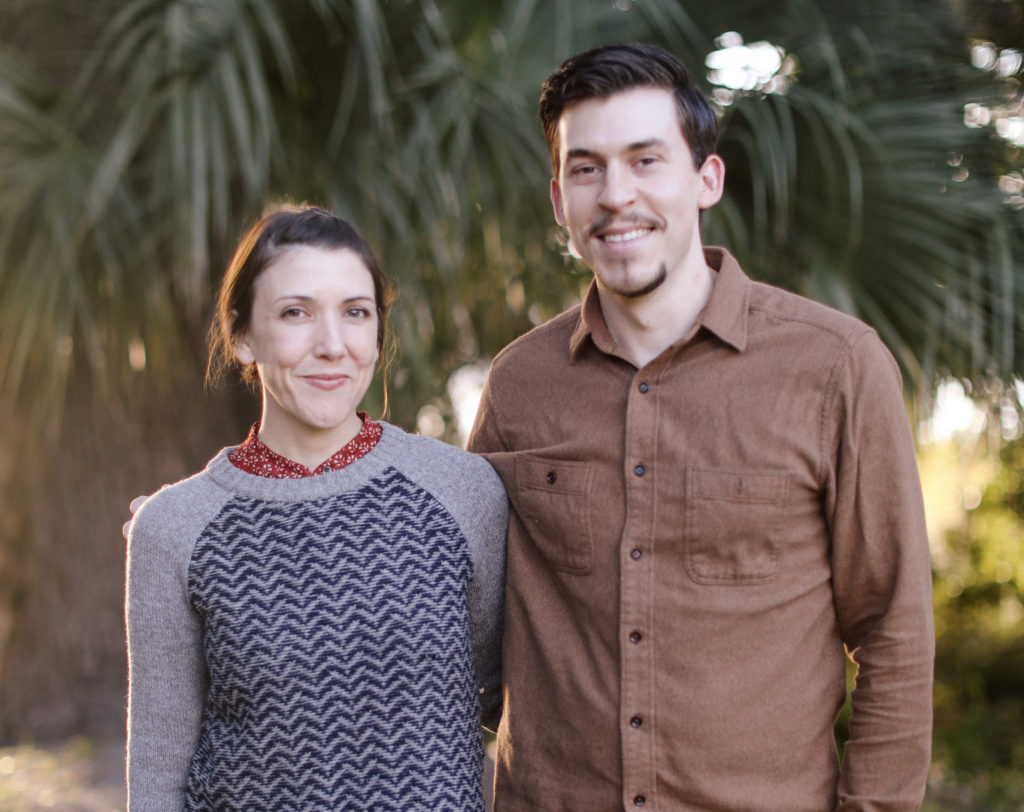
It is with our most sincere well wishes, and deep gratitude, that we say farewell to Whitney and Ben as they set out on their next adventures.
Introducing Greyfield Inn’s New Executive Chef Jada Veljkov

As we begin a new culinary chapter at Greyfield, we are so pleased to welcome Jada Veljkov as our new Executive Chef. Jada joins us from Athens, GA where she most recently served as the head chef of Hugh Acheson’s prestigious Five & Ten. Jada brings a minimalistic approach to the table – showcasing fresh vegetables from the Greyfield Garden while allowing sustainable and thoughtfully procured meats, seafoods, spices, and aromatics to complement the seasonal flavors, keeping her dishes rooted in a Southern style. We are thrilled to have Jada leading the Greyfield culinary program and wish her a warm welcome to Greyfield.
On behalf of,
Mary & Mitty Ferguson,
Owners and Managing Partners, and Team Greyfield
Follow along on Instagram for personal updates from Jada, Whitney, and Ben at @0jada0, @whitneyotawka, and @blwheatley87.
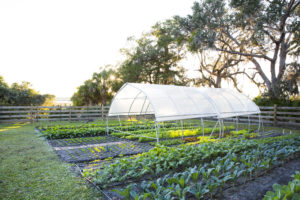
As the days get longer and temperatures climb, the garden starts to stand up tall. As tomato vines sprawl and peppers become heavy, crops benefit from a little support.
In the garden, we find it advantageous to trellis any climbing, viney crops like peas, pole beans, and cucumbers, or crops that bear heavy fruits like eggplant, peppers, and tomatoes. Trellising helps keep crops upright, creates better airflow, and reduces disease pressure. It also makes it hard for any ground dwelling critters to climb up and eat fruits and leaves. Supporting these crops also makes it easier to see and harvest the fruits, buttresses plants from high winds, and keeps their stems out of pathways.
TRELLISING FOR CLIMBING CROPS
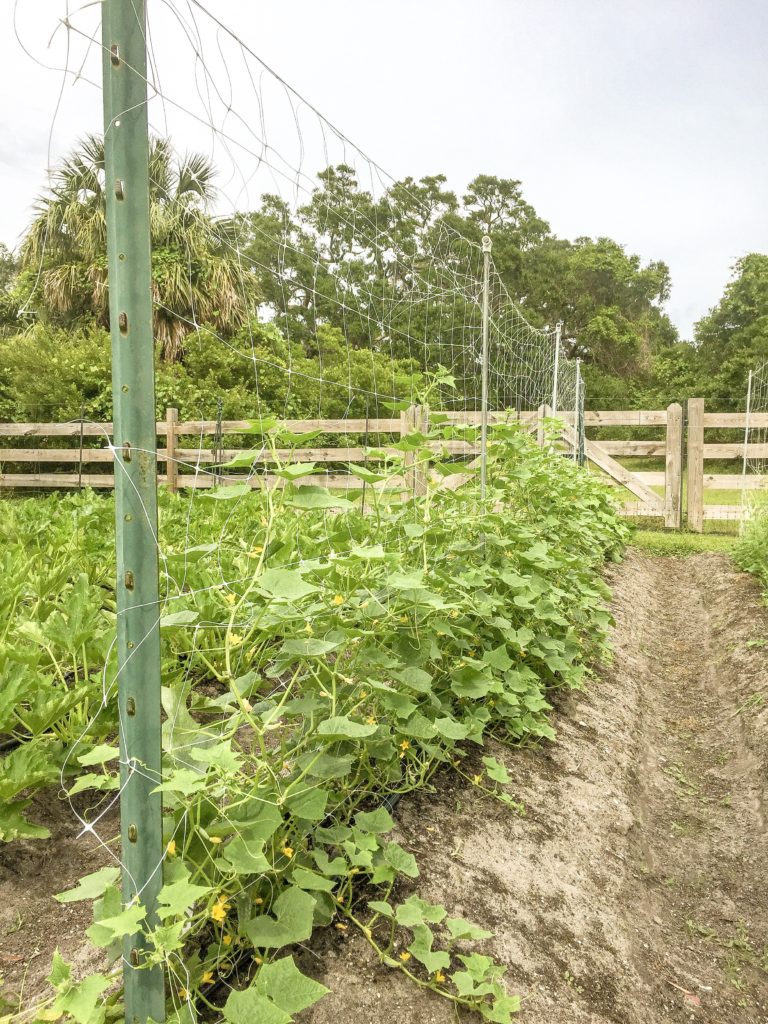
Trellising is all about timing. For climbing crops like cucumbers, beans, and peas, setting up a trellis system while the crops are young or just emerging from the ground is best. For these crops we use a plastic netting, but hog panels or welded wire works well too. Start by pounding 6-feet-long t-posts or sturdy stakes in the ground every four feet. Then, attach the netting to the stakes by either weaving it onto the posts or tying it with wire. Make sure there is tension from post to post to ensure a sturdy trellis. Installing this while the plants are young will encourage them to train up the netting right away. If not, the vines will begin to sprawl on the ground and you’ll have to manually train them to climb up the netting.
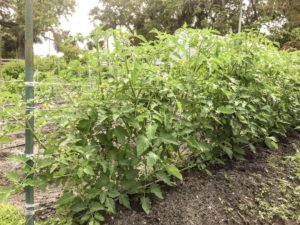
FLORIDA WEAVE TRELLISING
For crops like tomatoes, peppers, and eggplant, we like to wait until they are about a foot tall to start adding any support. For these crops we use a system nicknamed the “Florida Weave,” but also known as a Basket Weave. Like the previous trellis, you’ll start by pounding 6-feet-long posts every 4 feet. Using a polypropylene twine (you can purchase at Johnnyseeds.com or at a local feed store), start at the first post, wrap the twine around the post several times about six inches above the ground and tie a knot. From your knot, take the rest of the twine to the next post and wrap it around a few times making sure the string is somewhat level and very tight. Continue this until you reach you last post and tie it off. Now, start at that last post but on the other side of the crops and go back down the row so that there is string on both sides of the plants. As your crops get taller, you’ll want to add more twine to both sides about every six inches in height. Helpful hint: Do not use “natural” twines. They run the risk of breaking mid-season and your crops may collapse. Again, timing is key and waiting too long to trellis can make it harder to install, possibly damage crops, and will not be as effective.
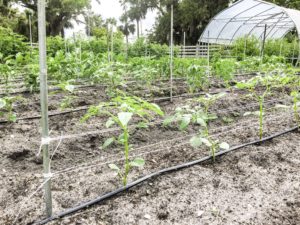
STRING METHOD TRELLISING

Our final trellis system is the “String Method” in our hoop house exclusively for tomatoes and cucumbers. A hoop house, or high tunnel, is a greenhouse-like structure covered in plastic that uses passive solar heating and venting to control the interior climate and create ideal growing conditions. For this method, we use thin metal cable, Rollerhooks from Johnnyseeds.com that have a spool of twine attached to a hook, and tomato trellis clips. In the hoop house, we install the cable running several feet above the row of crops to the end walls of the house. To make sure these cables are tight, use turnbuckles on either end. The Rollerhooks attach easily to the cable. Hang one above each tomato/cucumber plant. Pull the twine down to meet the base of the plant and use the clips to hold the stem of the plant to a taut trellis line. Now that you have a tight vertical string, you can wrap the stem or vine of the plant around the twine. You’ll need to continue to wrap the stem around the twine or add more clips at least once a week. If the plants ever reach the Rollerhooks, unroll more twine to drop the plants to the ground and they’ll continue to climb!

Now, you have a tall sturdy crop, fully supported and ready to harvest!
– Monica Ponce and Russell Honderd
Monica Ponce and Russell Honderd are the gardeners at Greyfield Inn.
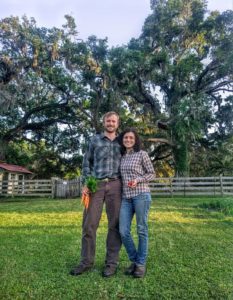
 Winter days on the island force you to move activities that might normally be in the water to a warmer place – above water. One of the best winter activities is fishing. Not only is it idyllic, tranquil, and downright perfect, but it’s also the best season to catch a whole lot of fish.
Winter days on the island force you to move activities that might normally be in the water to a warmer place – above water. One of the best winter activities is fishing. Not only is it idyllic, tranquil, and downright perfect, but it’s also the best season to catch a whole lot of fish.
The devil is in the details…
Now, in order to properly fish on the island, you have to learn from those who have been doing it for years. Trust me, I’ve been at it for 29 years and still need all the help I can get from my dad and his ever-expanding island knowledge. If you want to stay close to Greyfield, fishing from the dock is the place to go. The river in front of Greyfield is part of the Intracoastal Waterway and provides a perfect habitat for a variety of fish. The most commonly caught fish are trout and redfish, along with some sheepshead here and there. During the fall, winter, and spring months (when you may not be so keen to get in the surf), this is the spot to be and you’ll have a heck of a time spending an early morning or afternoon on the dock.
When it comes to the different types of fish we catch, that’s the fun part. One of our personal favorites is sheepshead. Sheepshead is an underutilized and slightly unknown fish, but they are local to our waters and are delicious! They are found amongst the rocks and pilings by the dock, and are typically caught by using fiddler crabs as bait. This is opposite of how you’d go about fishing for a trout or redfish which are caught on the surface. Sheepshead are, despite common belief, edible! We even (at times when we catch enough) put them on our menu at Greyfield – the best local catch which our guests thoroughly enjoy!
Outside of sheepshead, trout and redfish are our two other common catches. Fishing for trout and redfish is typically done using either shrimp or something called a “jig” (a lead-headed artificial lure) and is always on the surface of the water.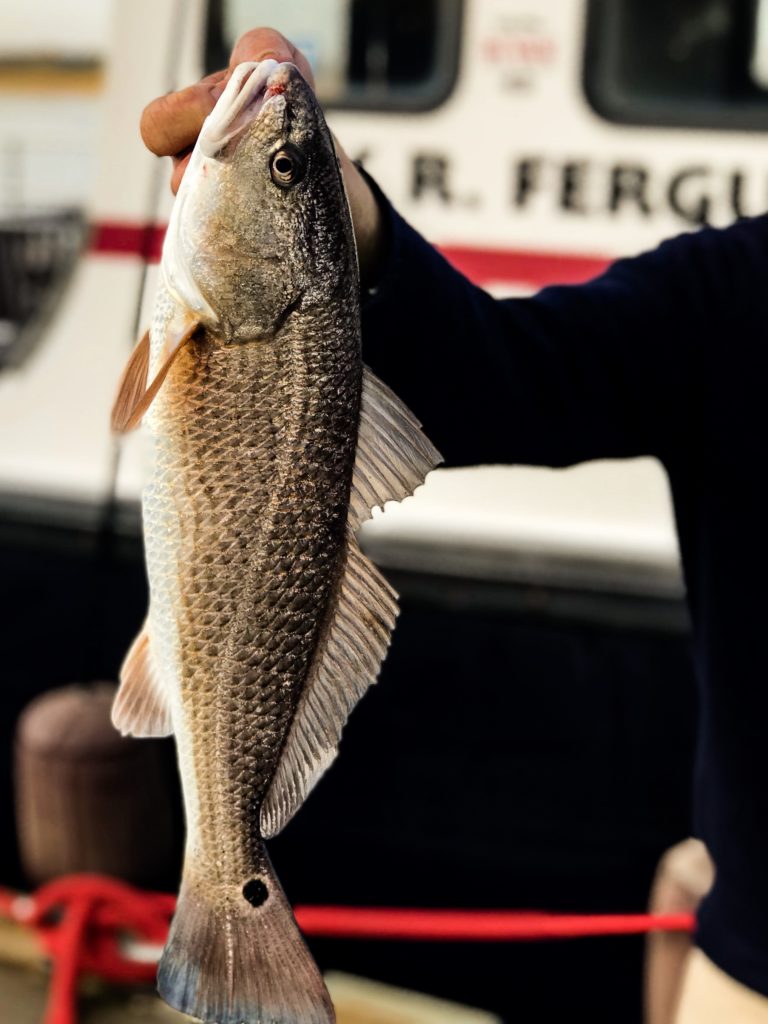 The fishing possibilities are endless!
The fishing possibilities are endless!
When the weather is milder, and we’re not so scared of a few splashes, we will load up the kayaks and head out for some fishing in the nooks and crannies of the river. For those staying with us, Greyfield also has kayaks at the dock which can provide wonderful opportunities for fly fishing (or just your average rod and reel!). There’s nothing quite as wonderful as sitting in a beautiful creek, in a kayak, amongst the magnificent peace and quiet. It’s truly a great way to spend a few hours…
In the summer, there is no doubt that the place to be is on the beach. You can catch a breeze, hop in the water, explore the beach, and best of all, get some surf-casting in! Fishing along the beach can be great in the summertime – typically June through most of October. On the island, we use cut mullet or shrimp for bait. The catch on the beach is reds and trout but can also include puppy drum and whiting.
As you can see, we’re huge advocates of exploring the beautiful land and taking advantage of the natural surroundings. Taking your lunch and spending some time at any of these spots, with a fishing rod, of course, is highly encouraged. We think it’s one of the best ways to spend some of your time on the island.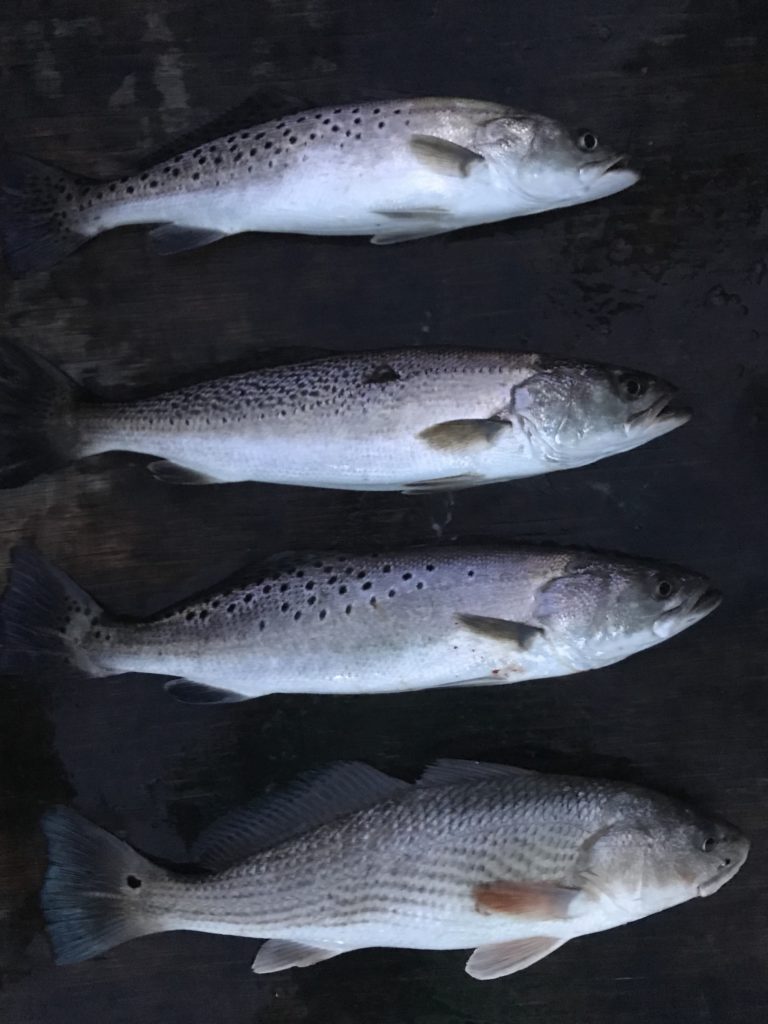 – Mitty Ferguson & Hadley Ferguson
– Mitty Ferguson & Hadley Ferguson
Mitty Ferguson is owner & operator of Greyfield and Hadley is his daughter, who grew up on the island and currently resides in Boston (spending every vacation possible at home, fishing with her dad).
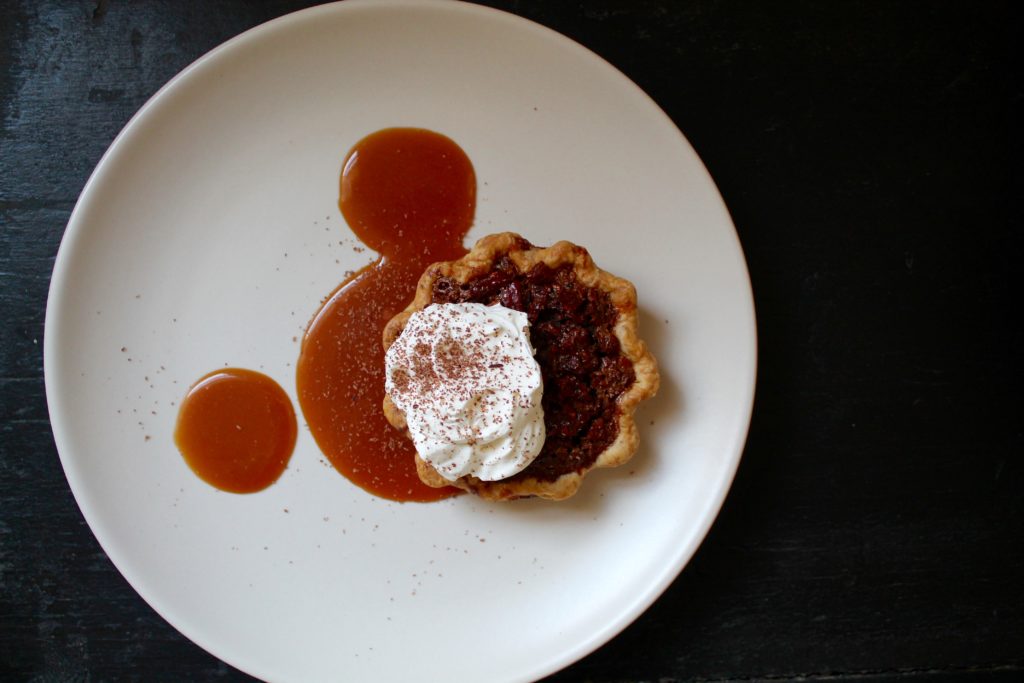
As a child, summer was always my favorite time of year. It meant no school, carefree days exploring the outdoors, and countless beach days.
As I’ve grown older, the heat and humidity of summer have become more oppressive, the summers-off no longer exist, and the responsibilities of “adulting” have become a reality. Fall has officially overtaken summer as my favorite season. There is just so much to love: crisp temperatures, falling leaves, cozy sweaters, and most of all, the food.
As the temperature here in the South has finally begun to drop, I find myself craving “comfort foods”: stews, braised meats, soups, and most of all, fall desserts. Those rich flavors of pumpkin, chocolate, apple and nuts along with the fragrant spices of cinnamon, nutmeg, and cloves always remind me of another reason to love fall, Thanksgiving. And what is Thanksgiving (or any other time of the year for that matter) without pie?
Pecan pie is one of my favorites and the following recipe incorporates both dark chocolate and coffee into the traditional filling. This adds balance to the sometimes cloying sweetness of some pecan pies. I especially enjoy a slice of this with a big dollop of whipped cream or a scoop of vanilla ice cream. I hope you do too.
Happy fall!
Georgia Kelly, Greyfield Inn Pastry Chef
Chocolate Coffee Pecan Pie (one 9” pie)
1 par baked pie crust (recipe below)
3/4 cup light brown sugar
1/2 cup light corn syrup
1/4 cup dark corn syrup
3 T melted unsalted butter
3 eggs
3 tsp instant espresso powder
1 tsp vanilla extract
1 tsp cinnamon
3/4 tsp salt
1/1/2 cups pecans, coarsely chopped
3 ounces dark chocolate (Valrhona 67% or other good quality dark chocolate)
Beat brown sugar and corn syrups. Add butter and mix until incorporated. Add eggs. Add espresso powder, cinnamon and salt. Add pecans and mix to coat. Sprinkle chocolate onto bottom of par baled crust. Top with pecan mixture. Bake at 350 degrees until set, about 40-45 minutes. If crust or filling become too brown, cover loosely with foil.
Pie Crust
1 1/4 cups flour
1/2 tsp salt
1/2 tsp sugar
8 T unsalted butter
4-5 T ice cold water
Pulse flour, salt, and sugar in food processor. Add butter and pulse until butter is about the size of peas. Slowly add water and pulse until dough just comes together. Wrap in plastic and chill at least 30 minutes. Roll out and line pie pan. Crimp as desired. Chill in freezer about 30 minutes. Line with foil or parchment and fill with pie weights or dried beans, Bake at 350 degrees for about 15 minutes until slightly browned. Remove from oven and remove parchment and beans. Return to oven and bake another 5-7 minutes.
Enjoy!
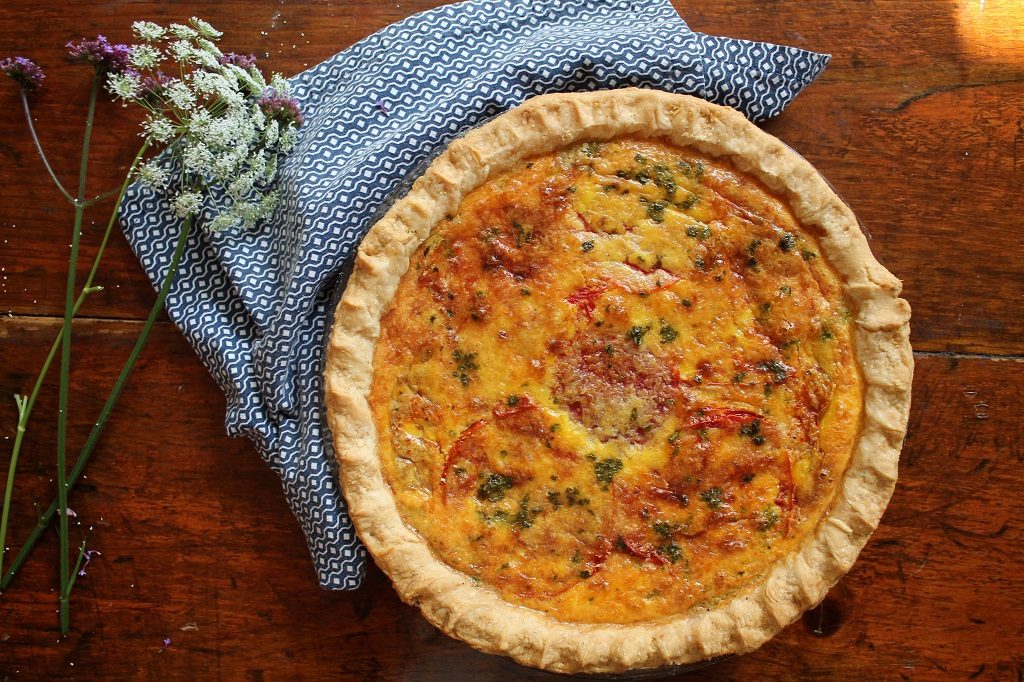
“I couldn’t tell you when I started making tomato pie. It’s not something someone taught me how to make. I am pretty sure its evolution took place during my years in the South but its origins, I claim them to be instinctual. It’s a marriage of my deep love of quiche (and everything French) married to the revelry of tomatoes in southern summers. I am not saying this is some invention of my own, but this is dish I could make blindfolded at 2am in a cave. I just make it.
Tomato Pie also takes me to a very fond cooking memory. Early in my career I was asked to make 12 tomato pies for a chef I was working for. He needed them for an event the following day. I was asked on a Saturday night, a very busy Saturday night when I was working a very busy station. Needless to say, the tomato pies had to be made after service. My nearest and dearest line cooking partner in crime, Ben, was also tasked with making Chicken Bog for said event. Our prep started around 11:30 pm. The restaurant closed down, the kitchen was empty except for the two of us. We cooked, talked, took a few nips of Pappy Van Winkle from the bar. It was perfect. I couldn’t tell you when I started making this pie, but I can tell you that it’s magical. I hope this recipe brings you as much happiness as I have had making it.” – Chef Whitney Otawka
Yields 1 Pie, 8 slices
Pie Dough*
1½ cups All-Purpose Flour
¾ teaspoon Sugar
¾ teaspoon Kosher Salt
1½ sticks Butter, diced and very cold
4½ tablespoons Water, very cold
In a mixing bowl, combine the flour, sugar and salt. Mix together to incorporate. Add in the butter and use your fingers to mix into flour mixture until it feels coarse and pebbly. Add in water and mix until all ingredients just beginning to become incorporated. Roll the dough into a ball shape and lightly flatten. Wrap with plastic wrap and refrigerate for at least two hours.
Preheat oven to 350 F. On a floured work surface roll out dough into a circle until it is uniformly around 1/8 inch thick. Line the pie pan with the dough and trim away the excess edge. Place into freezer for 15 minutes to chill well before blind baking. Line chilled dough with a circle of parchment paper that is 12 inches in diameter. Fill with whatever weights you have, such as beans or rice. Bake the piecrust for about 20 minutes. You want the edges of the pie to be a light golden brown when you remove it from oven. Allow to cool for a few minutes at room temperature, and then remove the parchment paper and weights. The pie shell is ready to filled and baked at this point. It can be made a day ahead, just wrap well and store in the refrigerator.
Pie Filling
2 Heirloom Tomatoes, medium sized
¼ cup Olive Oil
1½ teaspoons Kosher Salt
1½ cups Sharp White Cheddar (Cabot is a good starting point), shredded
4 Egg Yolks
6 Eggs
½ cup Heavy Cream
¼ teaspoon Dried Harrisa
¼ cup Parmesan, grated
1 teaspoon Parsley
Preheat the oven to 375 F. Slice the heirloom tomatoes to around ¼ inch thick. Lightly oil a sheet pan with olive oil. Lay tomato slices on oiled pan in a single layer. Use a ½ teaspoon of salt to season the tomatoes. Roast for 40 minutes. Set aside.
Reduce oven temperature to 350 F. In a bowl whisk together egg yolks, eggs, heavy cream, and 1 teaspoon salt. Whisk well, until slightly frothy.
To assemble pie, layer 1 cup of shredded white cheddar into the pie shell. Add in a single layer of roasted heirloom tomatoes, around half of the tomatoes. Next, add remaining ½ cup of shredded white cheddar. Top with remaining roasted tomatoes. Sprinkle dried harissa over the top tomato layer. Pour egg and cream mixture over the tomato and cheese filling. Top with parmesan and parsley. Bake for 45-55 minutes. The pie filling should be set and the top, golden brown. Allow to sit for 10 minutes. Serve for breakfast, lunch, or dinner!
* The pie dough recipe was taken from the cookbook Summerland by Anne Quatrano. Her book is a look at seasonal cooking in the Southern United States and a glimpse of her creative genius. Her cooking is incredibly inspiring and I highly recommend adding it to your library.

Follow along with more Tales from Chef Whitney Otawka’s kitchen by following her blog: www.whitneyotawka.com.
It is quite an exciting time to be a naturalist on Cumberland Island. From April to May, many seasonal changes have already been observed on the island. The Hooded Mergansers and other winter migratory birds have departed, and in turn, our spring and summer migratory birds have begun to arrive – including the Painted Bunting.
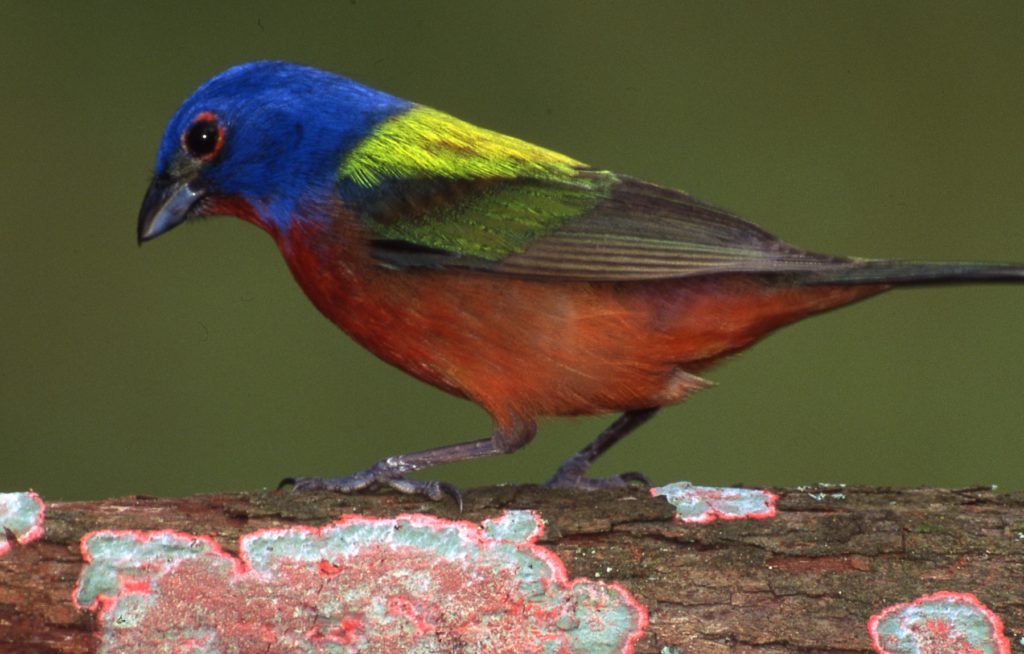
With summer quickly approaching (bringing along with it the warmer temperatures), we have even noticed changes in our flora. Our Sparkleberry Trees bloomed during April, and now our Southern Magnolias are starting to bloom. These seasonal changes could not have occurred at a better time, as we celebrated a handful of naturalist events throughout the month of April here at Greyfield Inn. April played host to Arbor Day, Jupiter being at opposition to the Earth (closest in its orbit for the year), Earth Day, and the birthday of famed coastal and American naturalist, William Bartram.
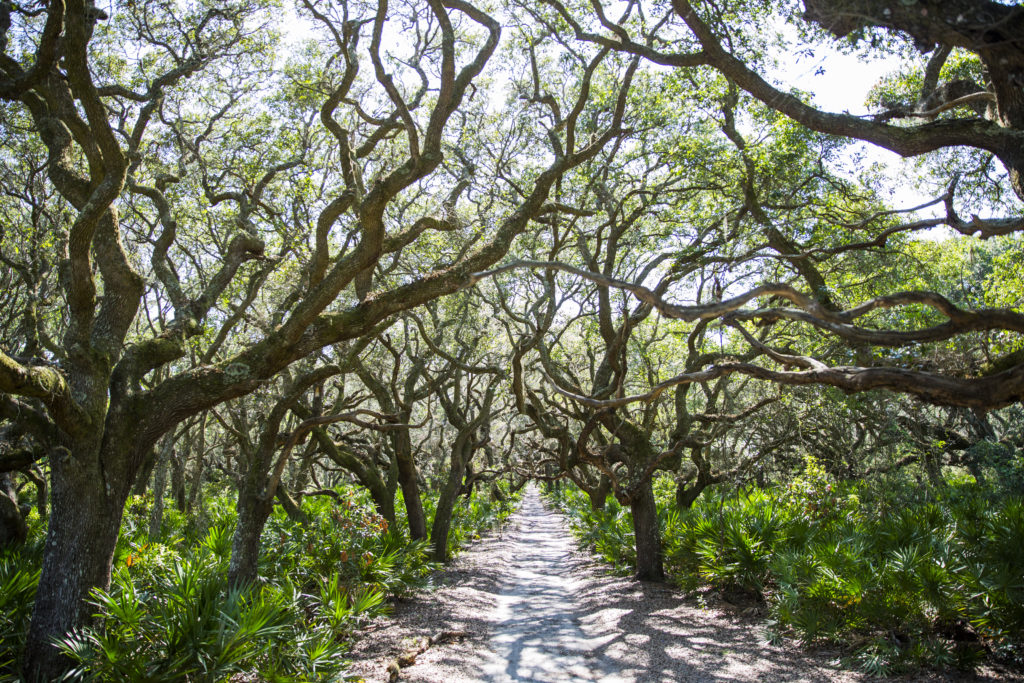
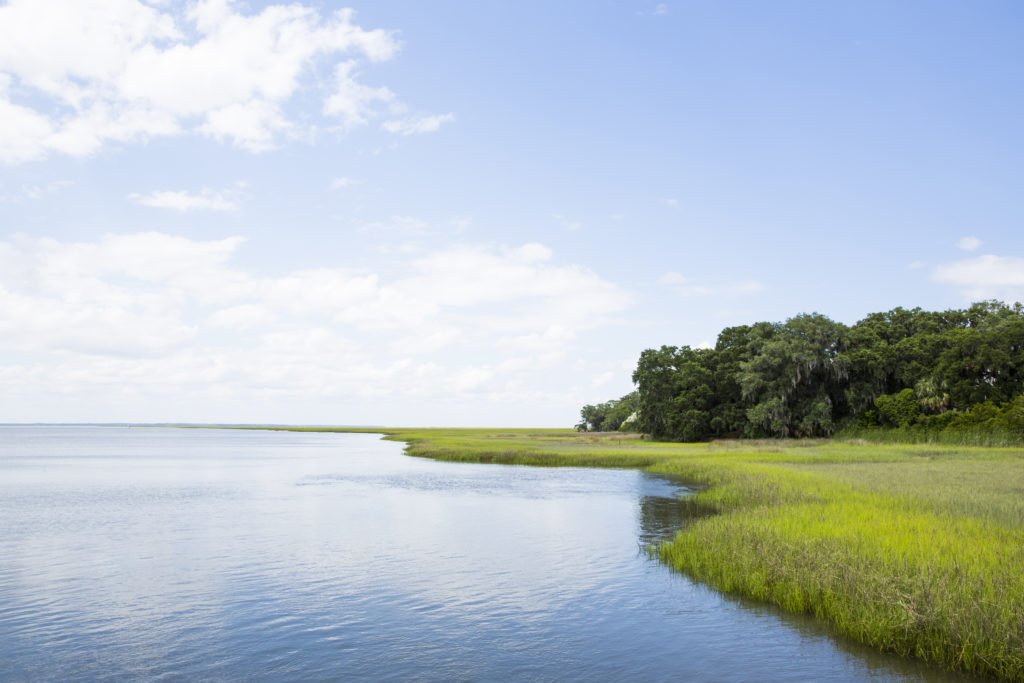
These seasonal changes also bring warmer water temperatures, which act as the catalyst to begin the sea turtle nesting season. Cumberland Island, with its protected seashore, plays a vital role in the sea turtle nesting season. At the time of writing this blog post, Cumberland Island has two documented nests for the 2017 season! With the discovery of these nests, the island has been host to the first sea turtle nests in Georgia for four years in a row. Just in the last three and a half seasons, Cumberland’s shore has produced over 1,800 nests. Each year, Cumberland Island accounts for 25-30% of the statewide nesting total. The protection and monitoring of these nests are vital to the sea turtle conservation efforts. With the nesting season lasting from May through October, we ask guests and visitors to be aware of the Loggerhead Sea Turtles nesting between the dunes and high tide line. It’s an exciting time with the nesting season beginning, and the Georgia Department of Natural Resources anticipates the nest number to be above average for 2017.
As May continues into June, we anticipate seeing more Loggerhead Sea Turtles as well as more seasonal changes. Some of the seasonal changes we are anticipating are the Saw Palmettos blooming and an increase in Fireflies on the island. Overall, the temperatures may be getting warmer, but with all the changes going on, it’s a great time to visit Cumberland Island and Greyfield Inn if you’ve never experienced these changes from spring to summer. As naturalists for Greyfield Inn, we will do our best to highlight these seasonal changes on our tours and hope you experience all the island has to offer.
– Alex Furness and Christina Nelson, Greyfield Inn Naturalists
Spring has arrived on Cumberland Island and we are savoring every moment. We love the foggy mornings in the garden — harvesting greens and roots in the crisp air while hearing the sound of waves crashing in the distance. Spring is also a season of promise, and we see signs of renewal throughout the island landscape. The live oak trees drop their leaves and push out shiny green foliage that brightens up the forest. The citrus trees are in full bloom, filling the gardens with their fragrance. Our honeybees are busy gathering nectar from the native flora beginning to bloom throughout the island’s vast wilderness.
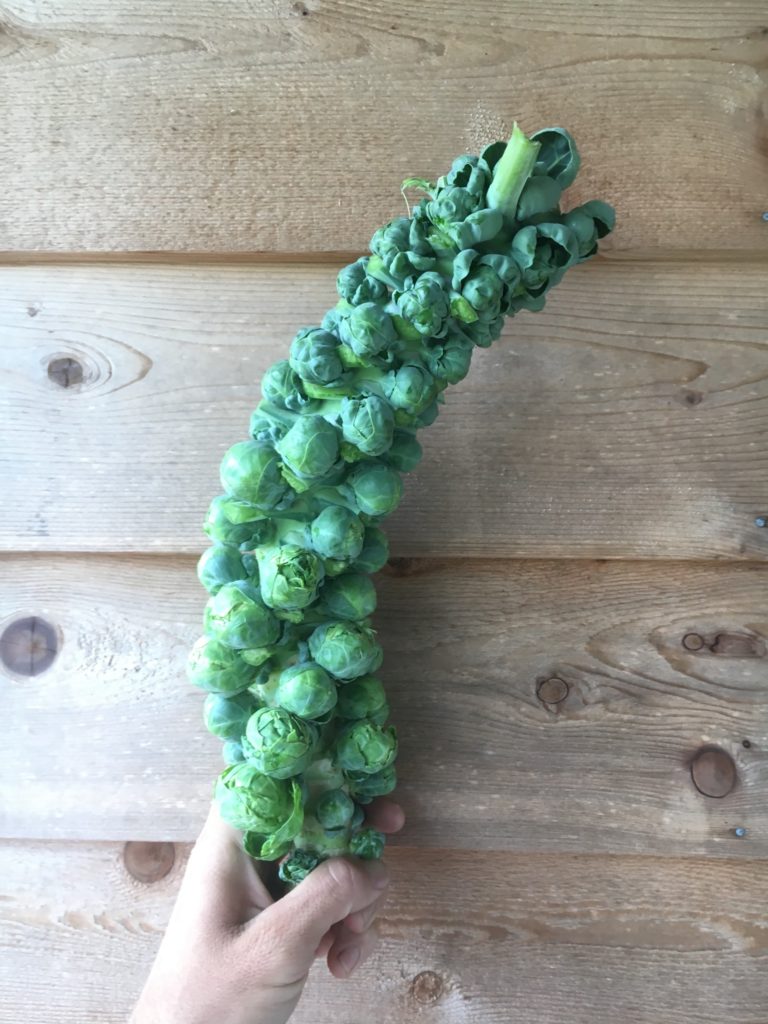
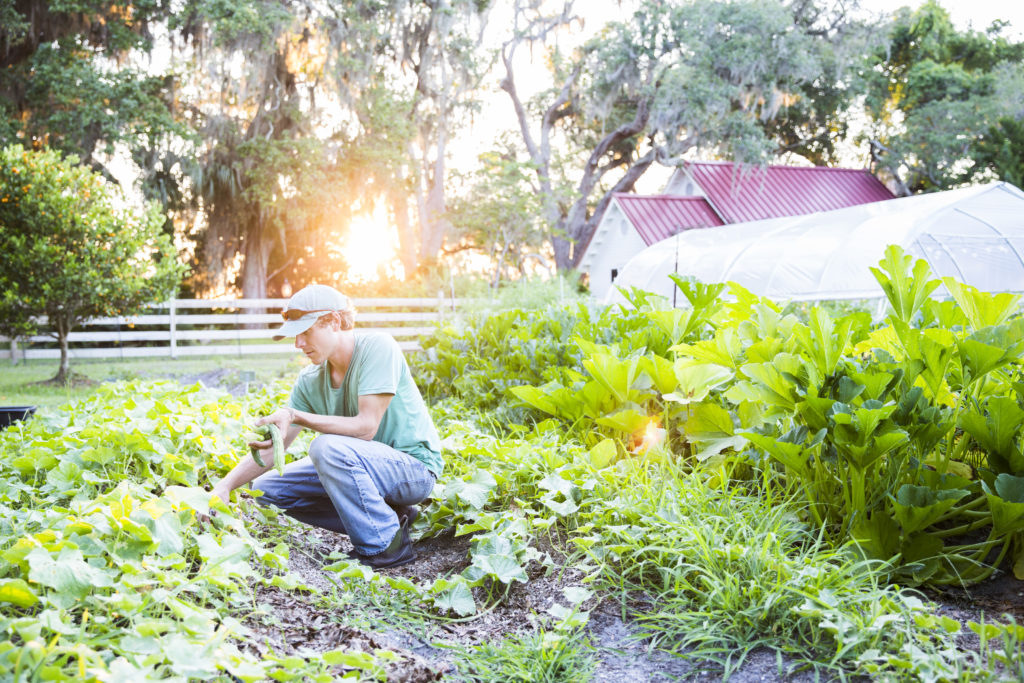
Spring is also a great time to garden on the coast. Our main growing season here is from October through June. Our mild winters make it possible to grow throughout the winter, and the arrival of spring is a time of bounty when cool and warm season crops overlap. We will continue to harvest our cooler season crops like lettuce and carrots, while also beginning to harvest our warmer season crops like squash, beans, and tomatoes. We overwinter flowers that cannot take the heat of the summer and the flower field is in full bloom with Snapdragons, Larkspur, and Bachelor Buttons. We will soon be clipping on classic summer flowers like Black-Eyed Susans, Zinnias, and Sunflowers. As things warm up, the diversity of crops in the garden begins to dwindle until we are left with okra, eggplant, and peppers that too will eventually succumb to the harsh summer heat on the Georgia coast.
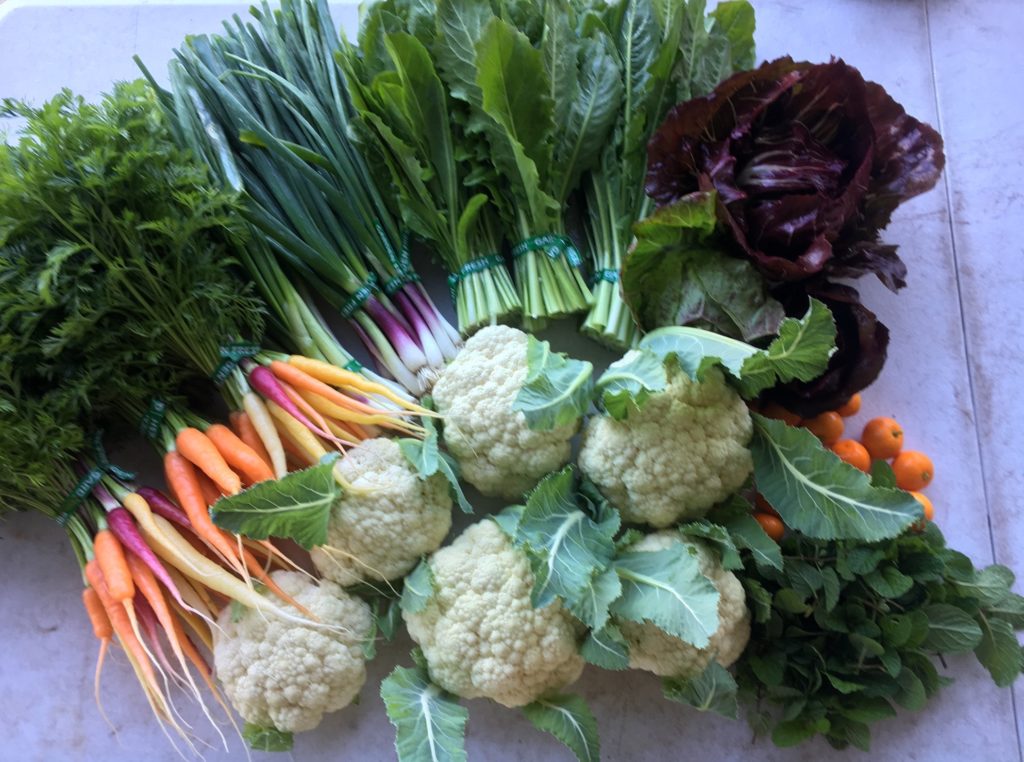
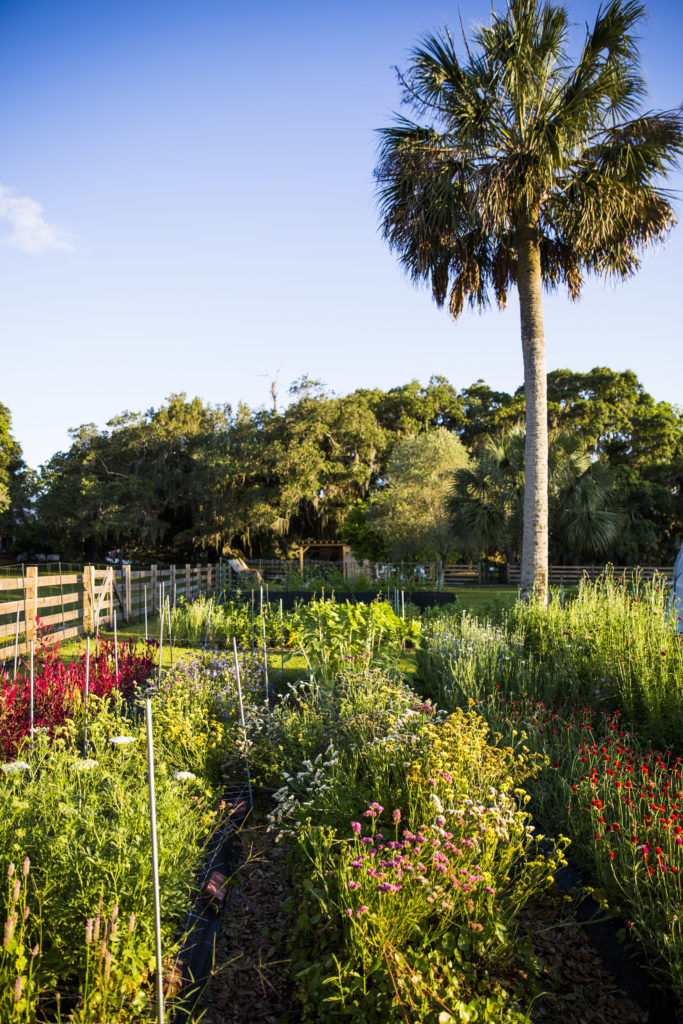
As in the gardens, spring is also a busy time for the Greyfield Apiary. We work with our mentor, Pete, to assess the strength of the remaining hives that made it through the winter. This year our apiary suffered some losses, but we were able to purchase new bees to go into the season with a full apiary. Just this week, we put on our first honey supers that will soon be full of capped honey for extraction in August.
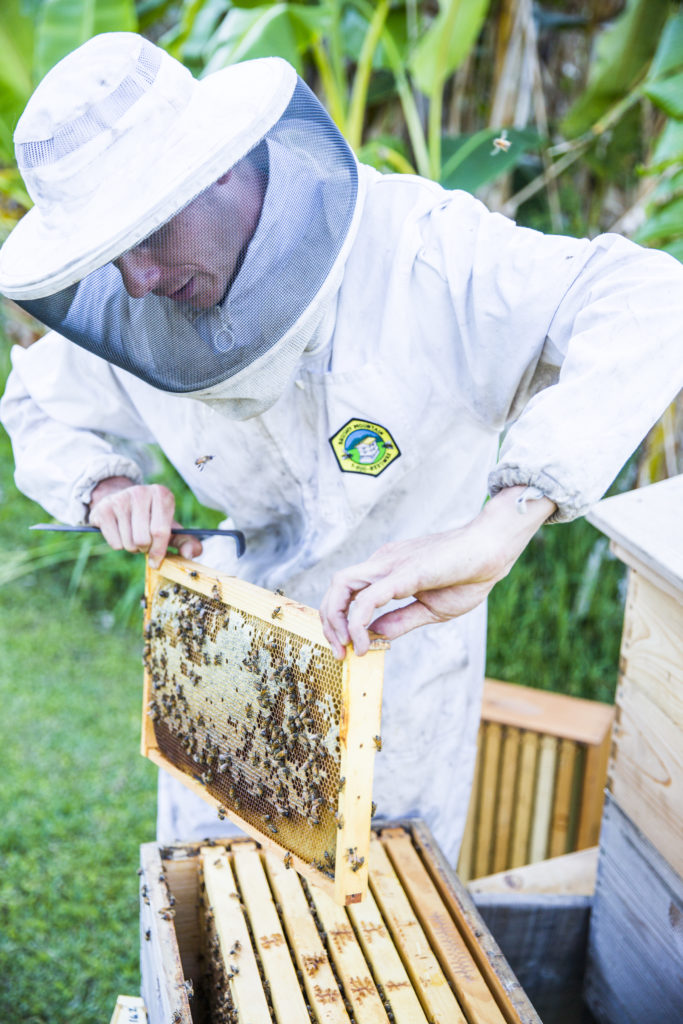
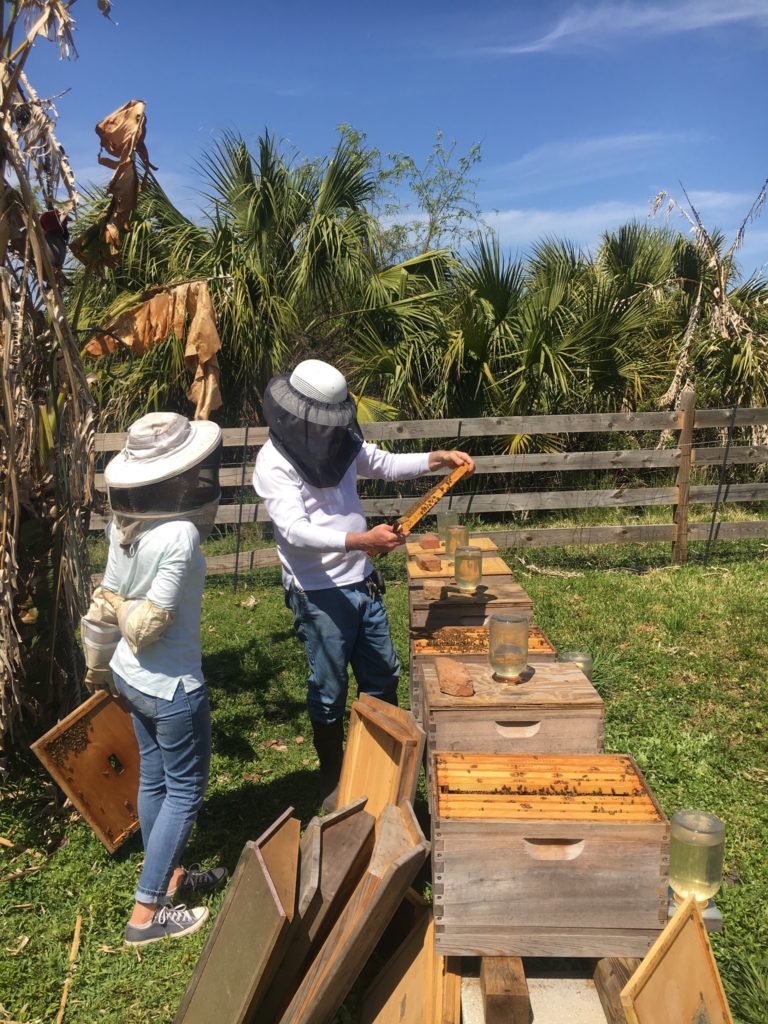
As gardeners, 2017 is our third season growing on Cumberland Island and seventh year farming full-time. Gardening on a Barrier Island is surely one of the most challenging environments we have grown in. At times, the pests seem relentless, the sandy soil requires constant inputs, and of course the weather (like any place) is unpredictable. With all these challenges though, we are always pushed to learn, experiment, and adapt. We are always trying new plant varieties and experimenting with different growing techniques, which over time has made the garden a beautiful and productive space. Every year, we get a little bit better at growing in this environment and are looking forward to the season ahead — working and living on this beautiful island

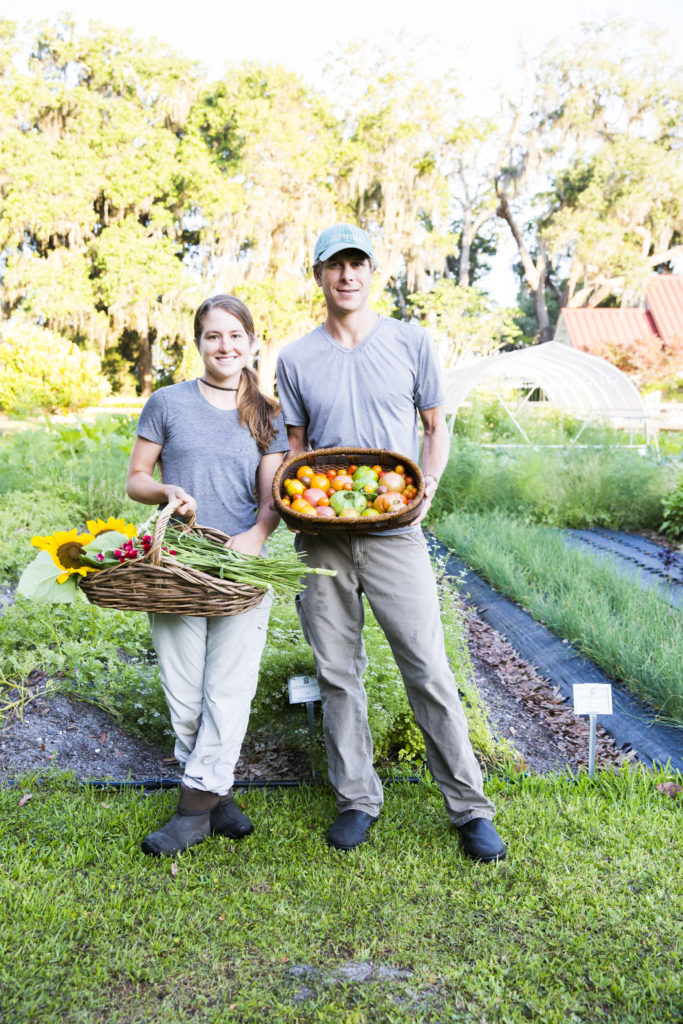
Greyfield Gardeners, Maya Velasco and Ryan Graycheck
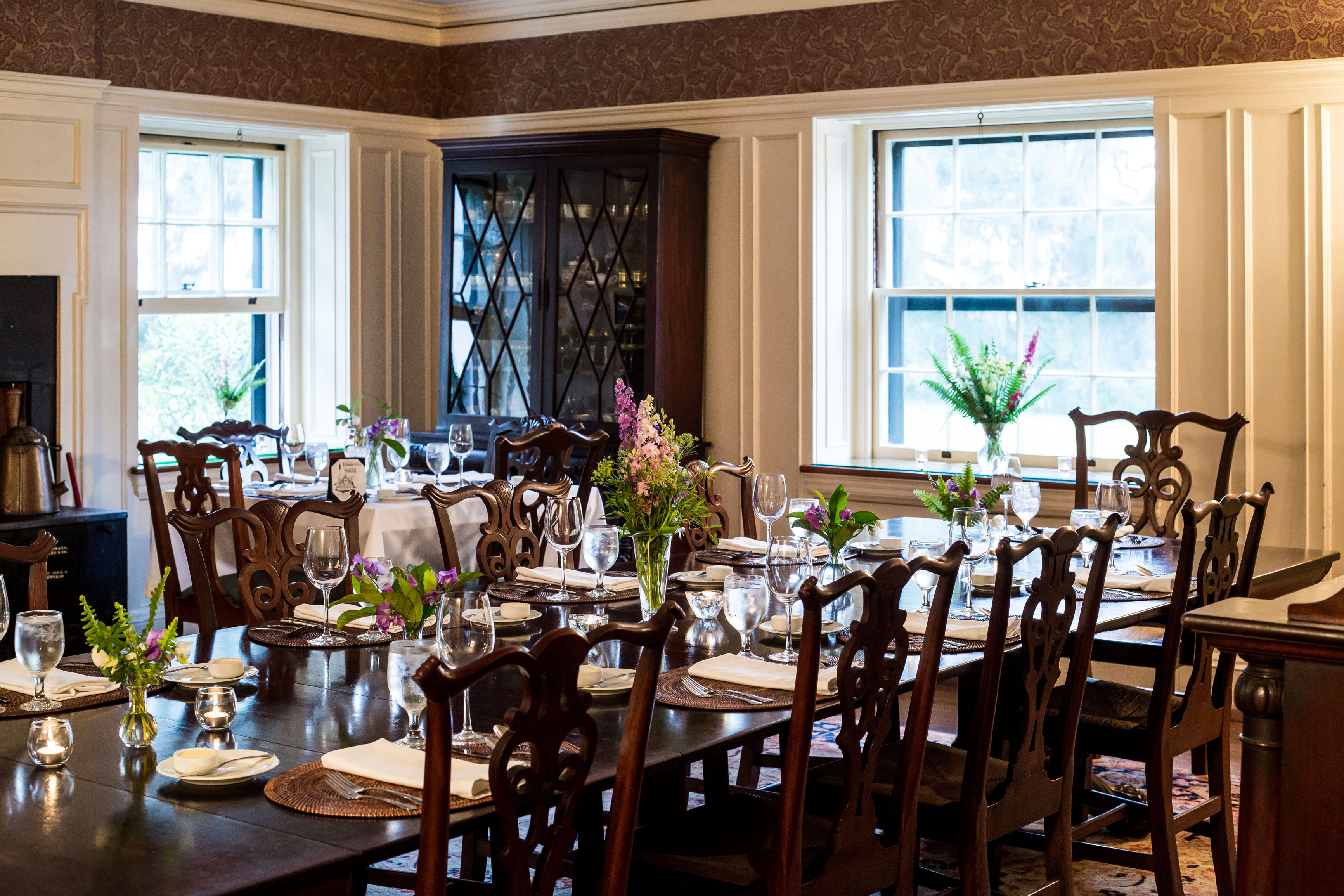
When the Question Really Is: What Wine Would You Want if You Were Actually on a Deserted Island?
On more than one occasion, I have heard both guests and staff remark that “change comes slowly to Greyfield.” Over the past year, I’ve come to observe that this is largely true. There are, of course, the cyclical, seasonal variances to rely upon: the early sunsets in winter; knobby-kneed foals in the spring. But as guests step off the Lucy R. Ferguson and walk the short path to the inn, they marvel at the same live oaks that generations before walked by every day. When they step inside, they’re surrounded by fixtures, furnishings, books, and paintings original to the home, collected and cared for by the family. At breakfast or dinner, guests are seated at the same dining room table where the Carnegie family took their meals. When the fires are lit, it is easy to imagine the same fires warming those gathered around them at the turn of the century. There isn’t even a landline at the inn; communications with our mainland office are carried out through VHF radio, and notes scurried back and forth on the boat. There is no Internet. Sometimes, the most exciting part of a day is watching the familial drama of a herd of wild horses play out in the backyard. Little horse operas full of mare-stealing and hoof-stomping.
So yes, change comes slowly here. Unless we’re talking about the inn’s wine list, that is. Over the past year, the wine offering has expanded from sixteen, mostly New World selections, to a list of largely European producers that hovers right around ninety wines. A year may sound like a while, but when you’re selecting wines for a property that is seemingly frozen in amber, it feels like light-speed. And the family wasn’t too interested in slowly peeling off the band-aid, either. I was instructed to “overhaul the whole darn thing.” That was the spring of 2015, when I would dip in and out as a free-lance consultant.
Eventually, it was clear the beverage program needed a full-time hand, and that really set the ball rolling.

Just Because You Build It, Does That Mean They’ll Drink It?
There were two things that I wanted Greyfield’s wine program to accomplish: the first was to offer bottles that complemented Chef Whitney Otawka’s southern-inspired, coastal plates. She and I worked together in various iterations in previous years, and I felt I understood her food, and delicate touch in the kitchen enough to quickly populate the list with a handful of trusted producers I was familiar with, nearly all of whom produce wines with a non-interventionist approach, good fruit, and essential acidity.
The second goal was to provide guests with plenty of opportunities to explore the breadth of wines without necessarily committing to a bottle. I didn’t want the kind of list that allowed for sleeper bottles to languish in storage until someone came along to take a chance on them. I just wanted to pop them open to share with folks. That’s when we decided to offer per-course wine pairings at dinner on Fridays and Saturdays.
The response on the part of our guests took me by surprise. There was a marked up-tick in dining room chatter about the wines after the nightly dinner announcements, and what seemed like relief at not having to fuss too long over which wine to choose. It also fostered spirited conversations between our staff, our guests, and myself. Wine offers a lot of opportunities to learn about all sorts of things: agriculture, geography, geology, world history, language. It’s a conversation-starter.
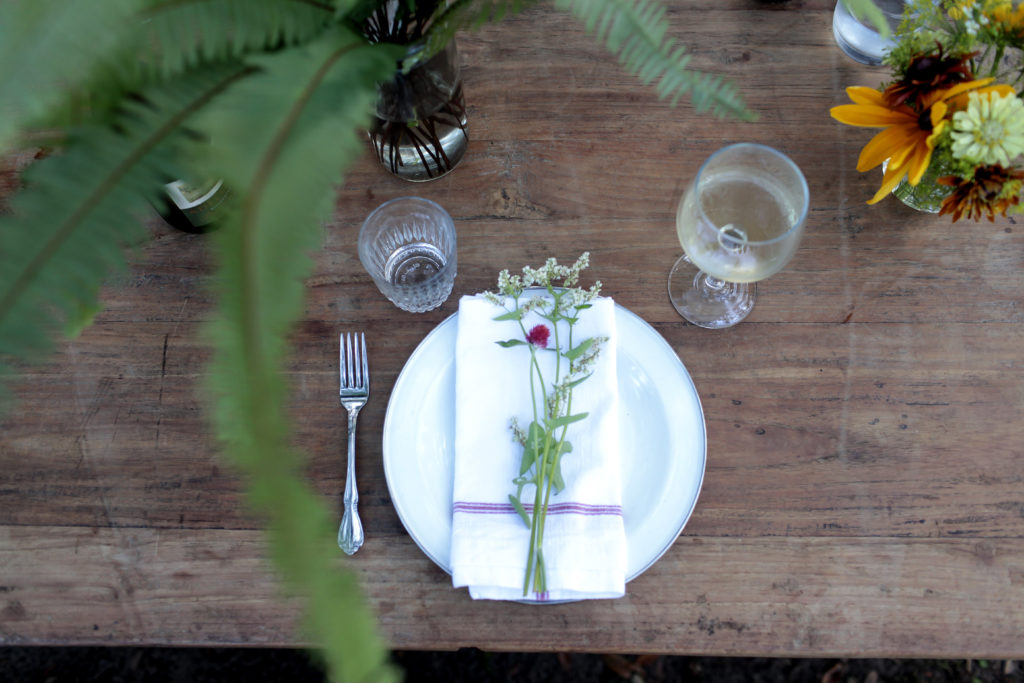
That said, I’m a big believer in showing someone something, rather than just lecturing them about it. Pairing nights proved to be the perfect setting for this. After a few months, we decided to expand pairing nights to Thursdays, and then Sundays. Now our diners are able to break free of the chard/cab bubble more often, if they choose, and experience for themselves how these wines stand up.
A lot of thought, conversation and, of course tasting, goes into choosing which bottles get pulled for any given night’s three-course dinner. There are pestering questions from myself to the chefs as they’re prepping. How acidic is the sauce? What are you doing to those parsnips? What kind of squash is in the soup? Are the nuts toasted, or raw? Then comes a steady stream of glasses to the kitchen for the chefs, and quick bites of a dish’s various components.
Greyfield’s is a seasonal kitchen. As the weeks progress, so do its meals, reflecting what is coming from Greyfield Garden, the surrounding waters, or local purveyors. Fall and winter are some of my favorite times to pull open more opulent white wines, like Vouvray or white Rhône blends, as well as delicate but structured red Burgundies, or Barbarescos. There’s an unending supply of root vegetables, squash, and winter lettuces the gardeners bring to the kitchen. Each plate provides various challenges to finding the right partner from the list. Sometimes, it takes a few tries.
Getting Specific
One dish that took some time to find the right wine for has become one of my favorite: oak grilled, wild-caught Georgia shrimp. I’m a Midwesterner, so shrimp isn’t something I naturally gravitate toward. As is often the case, however, Whitney makes it easy to be a late-to-the-party convert. After the shrimp come in from the oak wood-fired grill, they’re arranged over earthy heirloom beans, piperade, and charred onions, surrounded by a smoky tomato broth, often given a touch of heat from dried chiles. I tried a lot of juice for this plate: Sancerre (too dry); Riesling Kabinett (not bad, but often a little heavy handed); Savennieres (clobbered the dish). Then I turned to one of those languishing bottles that I admired, but often went under my own radar: Furmint Sec, or dry Furmint.
You may have tasted this little-discussed white grape if you’ve ever been lucky enough to sample the truly extraordinary Azú sweet wines of Hungary’s Tokaj region. But the late-ripening, thick-skinned grape can also make for alluring, full-bodied, dry wines. Typically, they exhibit considerable ripe orchard and tropical fruit notes, as well as slight nutty aromas. They tend to be higher in alcohol, but retain surprisingly balanced acidity and great aging potential.
The dry Furmint that was on our list, actually an Austrian one made by the talented Heidi Schrock, comes from the province of Burgenland, about five miles over the Hungarian border. I say “was,” because I was so pleasantly surprised by what I was sure would be a long-shot pairing, that the Heidi Schrock became a weekly go-to. And then, it was gone. No more left at the distributor. I wasn’t sure I’d find a suitable stand-in; the wine had all the hallmarks for a synergistic match with the shrimp. Its weighty apricot-laden palate held up to the spice; its acid worked perfectly with the tomato; its tasteful oak presence (something I’d normally avoid with most seafood plates) demonstrably played up the smoky oak flavors imparted on the sweet shrimp. The wine also had a kind of waxy, macadamia nut thing going on, too, which nicely handled the creamy beans with all their earthy flavors. It’s also gorgeous-looking in the glass- all golden-hued and honey-colored. All of this speaks to a wine that truly showcases a sense of place. The grapes come from one of the hottest micro-climates in Austria, in vineyards that form a horseshoe around Lake Neusiedl, which reflects the day’s sun back onto the vines, providing ample ripening. The wine is aged in large, acacia wood casks, giving it a structured backbone.
So, when I got down to my last bottle of the 2013 Heidi, I sadly removed it from the list, and squirrelled it away on the great onesies shelf, a constant reminder of past wine list soldiers. (There are some real finds there. You should ask me about them when you come to visit.)
I fumbled around for a few weeks with various Burgundies, Loire whites, and both dry and off-dry Rieslings. None were awful, but none of them seemed to pick up and run with it, in my opinion. Then I became aware of what is considered to be a hallmark producer in Tokaj, Hungary: Kiràlyudvar (pronounced Kee-RYE-oohd-var), an estate that farms its volcanic soiled vineyards organically. The grapes ripen in a unique climate of rainy autumns and long Indian summers. It’s then aged in large Hungarian oak casks.
Here we had a Furmint that proved to be a little more viscous, slightly more ripe and tropical, less nutty, and no less beguiling. Another 2013, this Furmint sec proves the age-worthiness of the wines; there’s still impressive acidity and lift behind all that fruit. This wine also seems to hone in on the shrimp’s slight smoky heat with a little more precision.
Just this week, the distributor for both these wines found a lone case of the Heidi Schrock Furmint in a New Jersey warehouse. So guess who’s coming back to Cumberland for a longer stay? I’m excited to taste these wines back-to-back. On a list as small as ours, it may look strange to have two similar oddities, but I hope the always-changing, ever-evolving selection at Greyfield helps to shed light on lesser-known producers and varietals. I think a good wine list can be any size, as long as it seeks to bridge gaps and spark intrigue.
So, come visit. Disconnect, and re-connect, as we like to say. Pour yourself some wine, look at some horses, and maybe think how the stuff in your glass connects you to the whole wide world.

Cheers!
Christopher Becerra, Service & Beverage Director

P.S.
You can see our current wine list here.

Culinary Director Whitney Otwaka has been hard at work this summer creating delicious meals each day for the guests of Greyfield Inn. Sourcing most of her ingredients directly from Cumberland Island and the Greyfield Garden, she uses seasonal produce and fresh catch to create her refined southern dishes. When not working on Cumberland Island, Whitney’s been embarking on culinary adventures to draw on some fresh inspiration. Take a look at what she’s been up to in the past few months and some of the exquisite meals she’s been making!
A Taste of the Georgia Coast
This May, Chef Whitney teamed up with Georgia Organics to combine the best of Greyfield Garden with produce from other organic Georgian farms, resulting in a delicious and food-filled weekend to celebrate local food.
![FullSizeRender[1]](http://greyfield.wpengine.com/wp-content/uploads/2016/06/FullSizeRender1.jpg) In true southern fashion, the weekend kicked off with a low country boil on our front lawn.
In true southern fashion, the weekend kicked off with a low country boil on our front lawn.
 The second night’s multi-course meal featured White Oak Pastures chicken and ricotta dumplings with sweet peas, baby squash, and Calabrian Chili Oil.
The second night’s multi-course meal featured White Oak Pastures chicken and ricotta dumplings with sweet peas, baby squash, and Calabrian Chili Oil.
Eats on the island:
As culinary director, Whitney has her hands involved in all aspects of Greyfield Inn’s dining experience – from harvesting to preparing to plating.
 This sheepshead fish made its way from the ocean to Greyfield’s dinner table within hours. The sheepshead is a flaky white fish that’s commonly caught off the coasts of Georgia and northern Florida.
This sheepshead fish made its way from the ocean to Greyfield’s dinner table within hours. The sheepshead is a flaky white fish that’s commonly caught off the coasts of Georgia and northern Florida.
 Combining cantaloupe, Mexican sour gerkins, micro basil, mint, peppercress, lime, and espellete creates a refreshing afternoon snack. While these ingredients shine on their own, the medley harmonizes them to maximize their flavors.
Combining cantaloupe, Mexican sour gerkins, micro basil, mint, peppercress, lime, and espellete creates a refreshing afternoon snack. While these ingredients shine on their own, the medley harmonizes them to maximize their flavors.
 Cucumbers from Greyfield Garden make a refreshing cucumber and buttermilk soup with pickled Georgia shrimp, ice lettuce, espellette, and olive oil.
Cucumbers from Greyfield Garden make a refreshing cucumber and buttermilk soup with pickled Georgia shrimp, ice lettuce, espellette, and olive oil.
 Fresh tomatoes are a staple in summertime dishes in the south. The first picks this season were paired with filet beans, sheep’s milk feta, spring onions, and green garlic for a flavorful salad.
Fresh tomatoes are a staple in summertime dishes in the south. The first picks this season were paired with filet beans, sheep’s milk feta, spring onions, and green garlic for a flavorful salad.
 Greyfield Inn guests are sent off with picnic baskets filled with Georgia shrimp rolls to enjoy between bird-watching tours and bike rides.
Greyfield Inn guests are sent off with picnic baskets filled with Georgia shrimp rolls to enjoy between bird-watching tours and bike rides.
Culinary adventures near and far
Taking a break from Cumberland Island, Whitney crossed the Atlantic for a visit to Copenhagen. She spent time exploring the culinary history and culture of the Nordic land.
![FullSizeRender[2]](http://greyfield.wpengine.com/wp-content/uploads/2016/06/FullSizeRender2.jpg)
![FullSizeRender[3]](http://greyfield.wpengine.com/wp-content/uploads/2016/06/FullSizeRender3.jpg)
![FullSizeRender[4]](http://greyfield.wpengine.com/wp-content/uploads/2016/06/FullSizeRender4.jpg)
Follow Chef Whitney Otawka (@whitneyotawka) on social media to stay updated on what she’s up to!
You are using an old version of Internet Explorer. Our site is developed with the latest technology, which is not supported by older browsers
We recommend that you use Google Chrome for accessing our (or any) website. It is a FREE and modern web-browser which supports the latest web technologies offering you a cleaner and more secure browsing experience.